Fabian Hürzeler has gained attention for his tactical approach with his work at Brighton and Hove Albion. Known for blending modern football principles with creative strategies, Hürzeler has crafted a system that makes Brighton one of the most intriguing teams to analyze. This tactical analysis breaks down the key elements of his game plan, from their fluid formations to the pressing systems and attacking transitions that define his style. By examining how Hürzeler structures his team, we gain insight into the strategies that make Brighton a tough opponent in every phase of the game.
Build-up
Goal-Kicks
Hürzeler sets his team up in a 1-4-2-2-2 formation when they have goal-kicks.
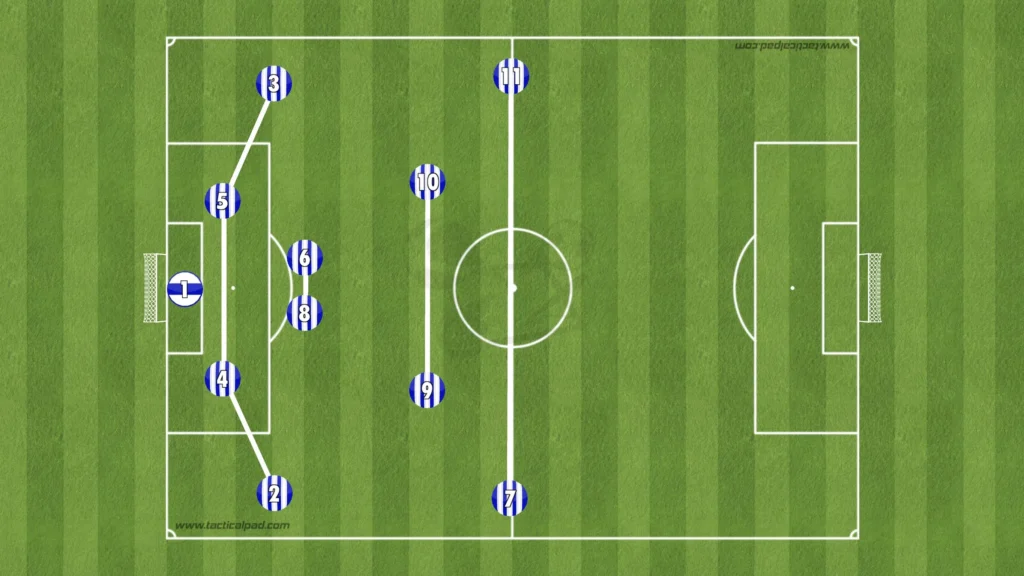
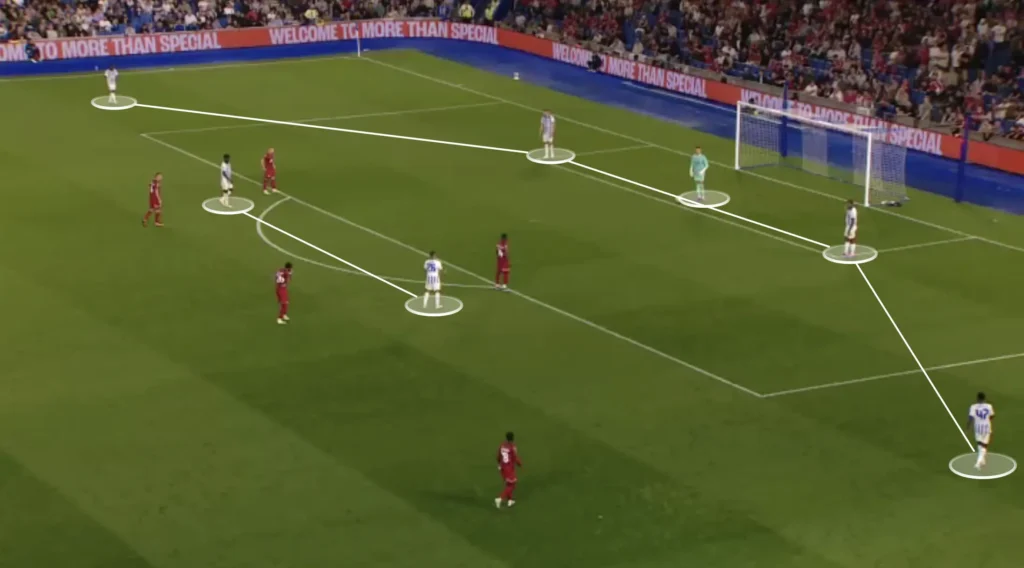
He uses two dropping strikers/number-tens and looks to attract opposition players to open up the space in behind for the wingers to exploit.
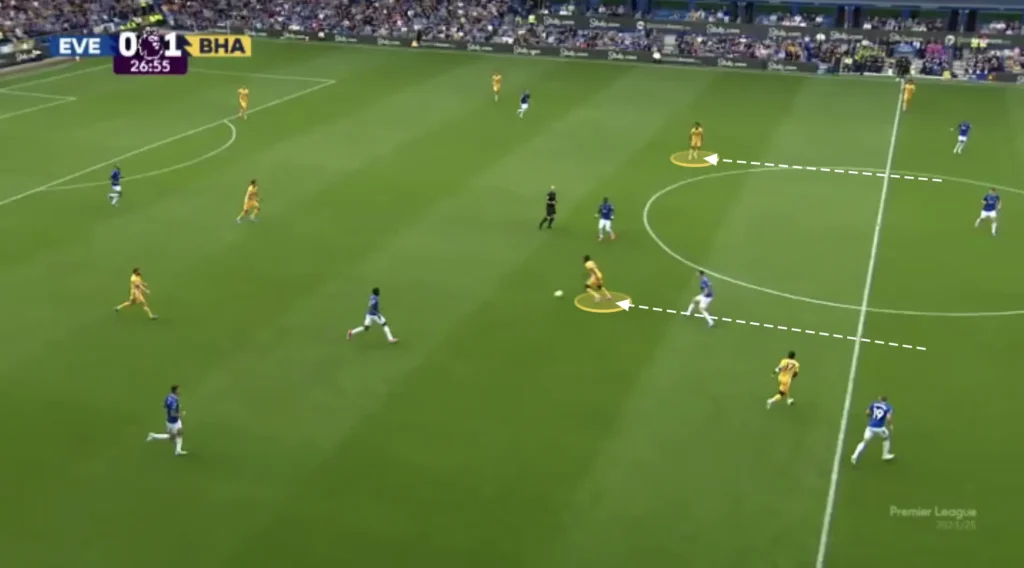
This structure with two dropping strikers and two high wingers, popularized by the former Brighton coach Roberto De Zerbi, questions the opposition center-backs, forcing them to make difficult decisions. If they push up on the dropping strikers, the space behind them opens up, giving the winger a 1v1 against the fullback in a massive space.
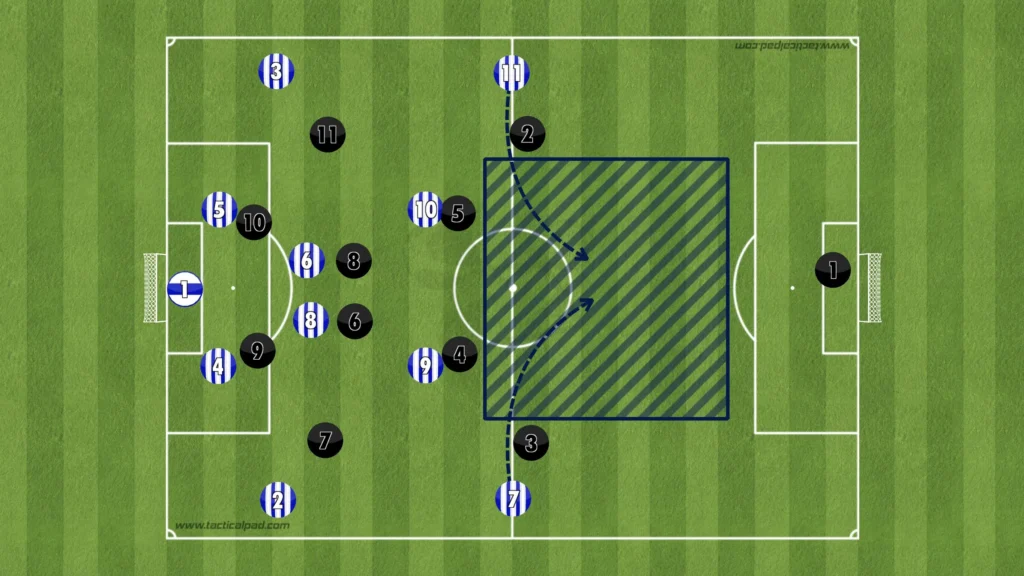
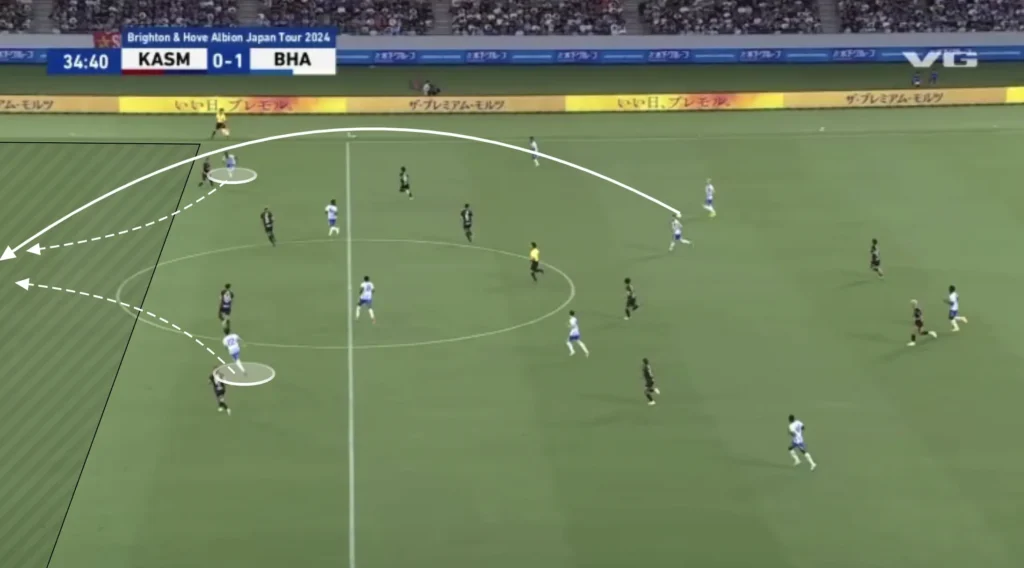
However, if they do not push up on the strikers, a numerical superiority is created in the midfield, allowing Brighton to play through the press.
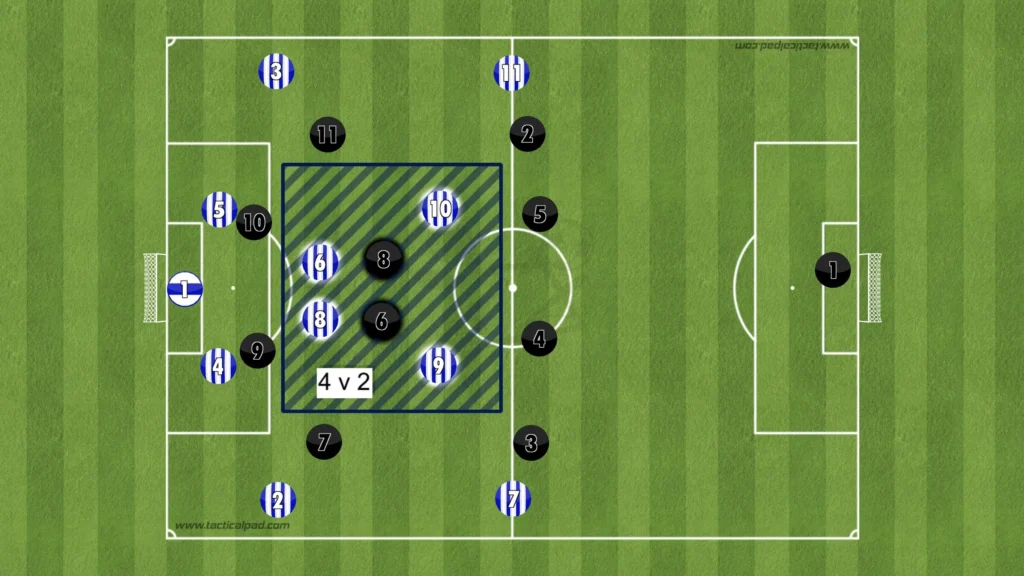
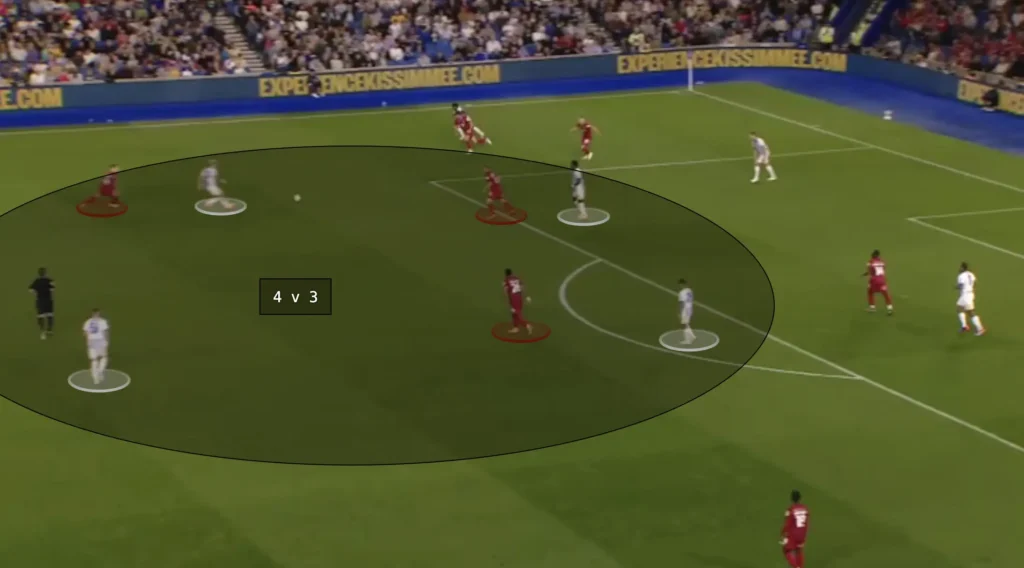
The Brighton center-backs and goalkeeper will either play the fast long ball toward the attackers or use third-man combinations with the holding midfielders to beat the first press. If they beat the first press, the center-backs will take the ball forward and try to find passes into the midfield or out to the wingers.
Low Build-up
In the low build-up, Hürzeler sets his team up in a 1-4-3-3 formation with a back four, one number-six, two number-eights, and a front three. “Low build-up” refers to the situations where Brighton have to restart the build-up low down the pitch with the goalkeeper and center-backs, but not from dead balls like goal-kicks and free-kicks
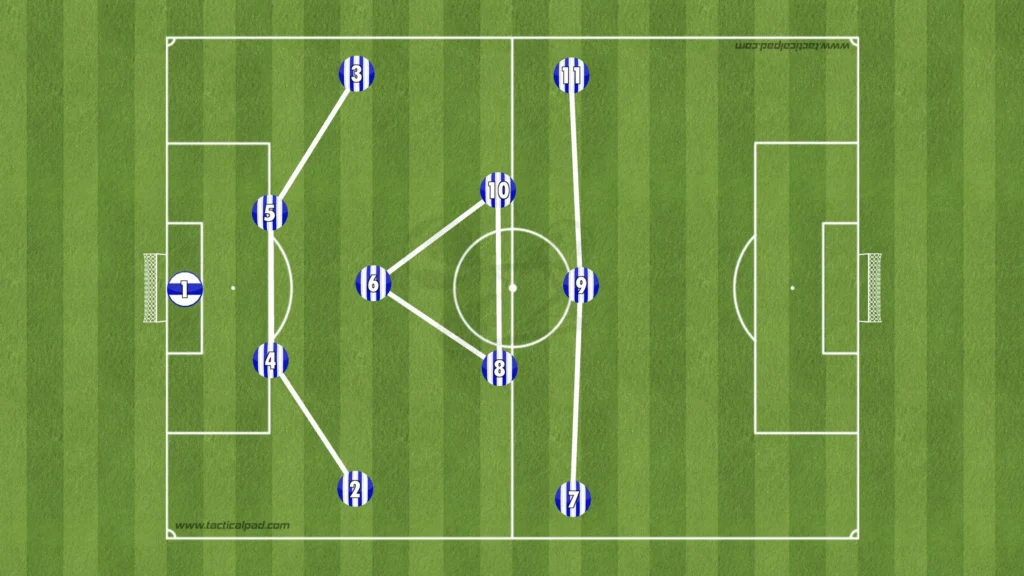
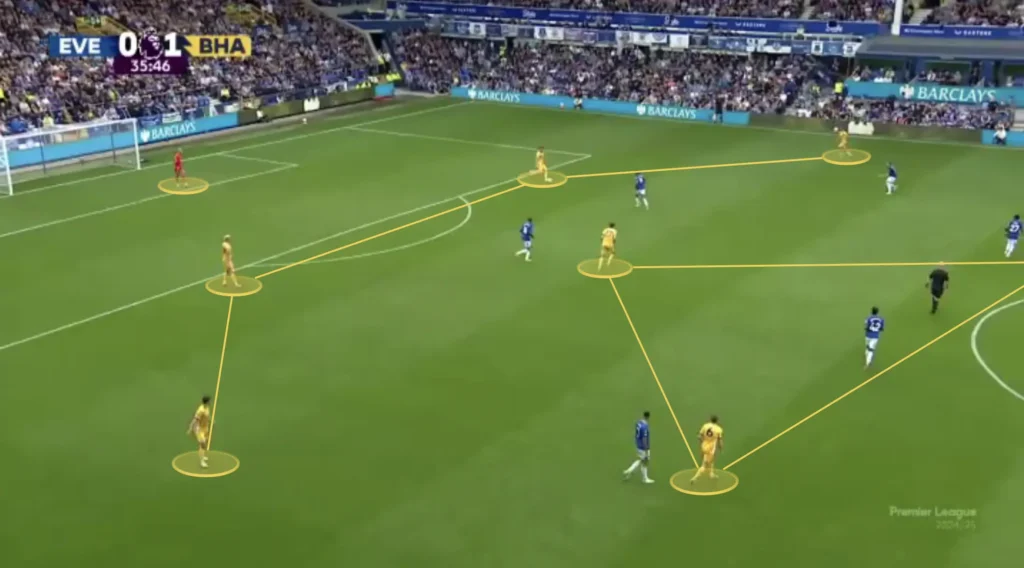
Building up in a 1-4-3-3 formation focuses on creating a solid foundation at the back while maintaining fluidity and options in the midfield. The formation begins with four defenders, who provide width and stability, allowing for controlled possession from deep areas. The single defensive midfielder connects the defense to the midfield, dictating the tempo and distributing the ball to the two more advanced central midfielders. These midfielders position themselves to exploit spaces between the opposition’s lines, creating passing triangles that facilitate smooth progression up the pitch. The three forwards, with the central striker as the focal point, are always ready to receive the ball, either through direct passes or by making runs behind the defense. This setup allows the team to transition quickly from attack to defense, maintaining pressure on the opponent while ensuring defensive coverage.
High Build-up
In the high build-up, the Brighton fullbacks invert into the midfield. They will come into the midfield next to the number-six, with the wingers staying as wingers and the number-eights pushing up as the attacking midfielders.
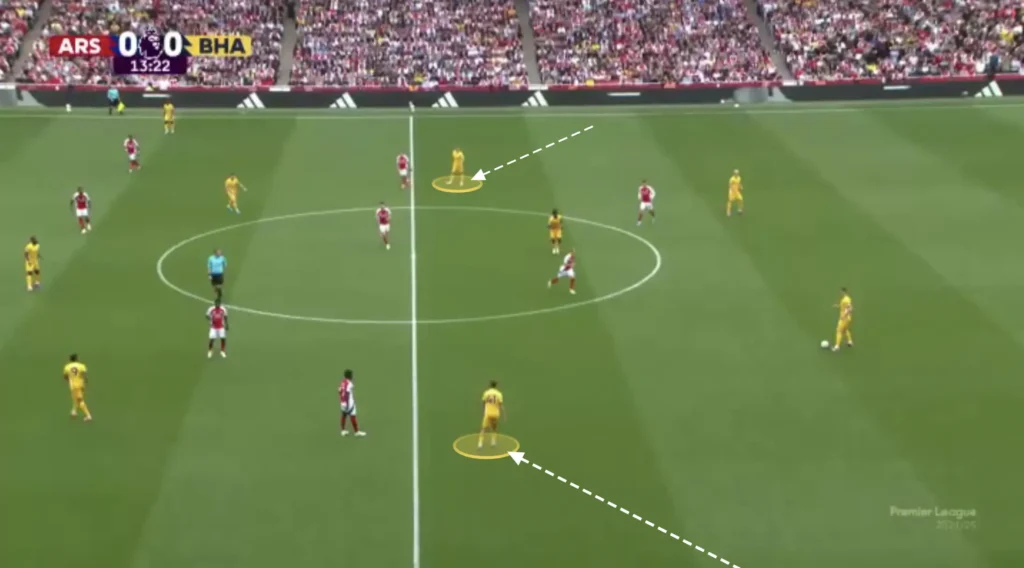
This creates a 1-2-3-2-3 structure:
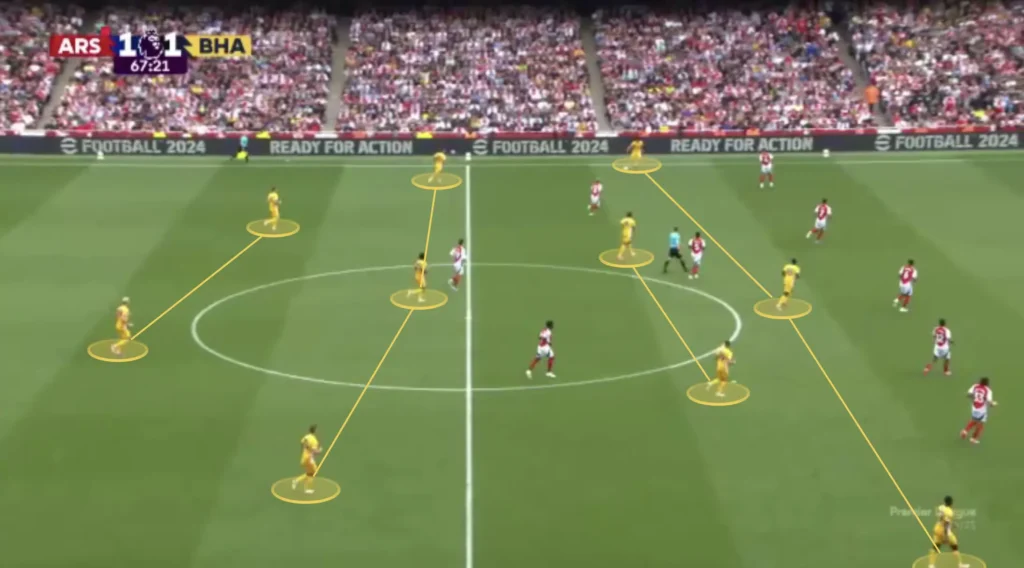
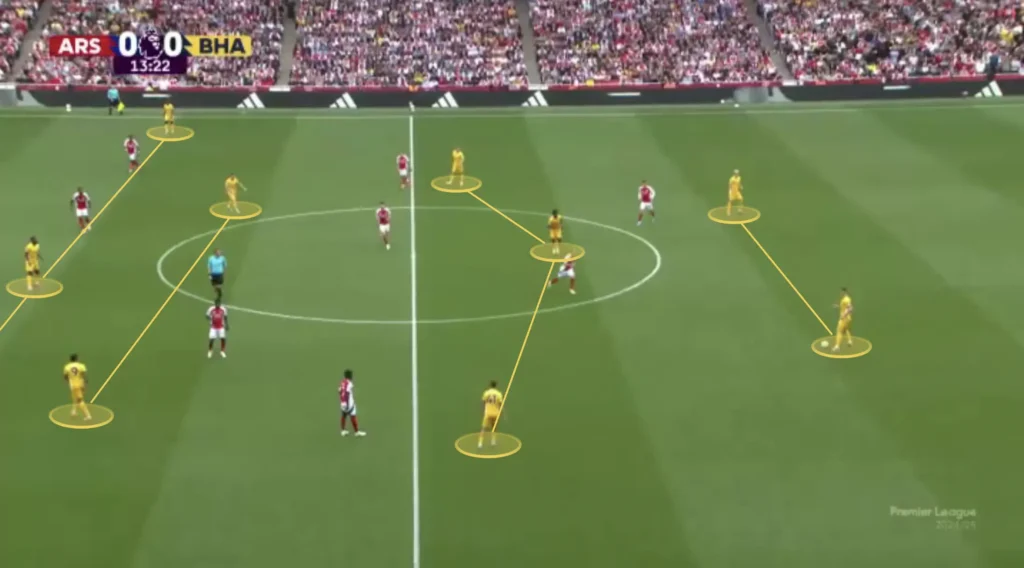
The 1-2-3-2-3/1-2-3-5 formation allows for a strong presence in the midfield, which helps in controlling the game and dictating the tempo. The two central defenders provide a solid foundation for recycling possession, while the three holding midfielders can effectively link play between defense and attack. The five forward players, including wingers and strikers, stretch the opposition’s defense, creating space and overloads in key areas.
Additionally, when the fullbacks invert, the opposition wingers usually follow to cover the run, which opens the passing lane from the center-back to the winger. The center-back can play the ball to the winger, who can attack the opposition fullback and combine with the number-eight to create a 2v1 situation.
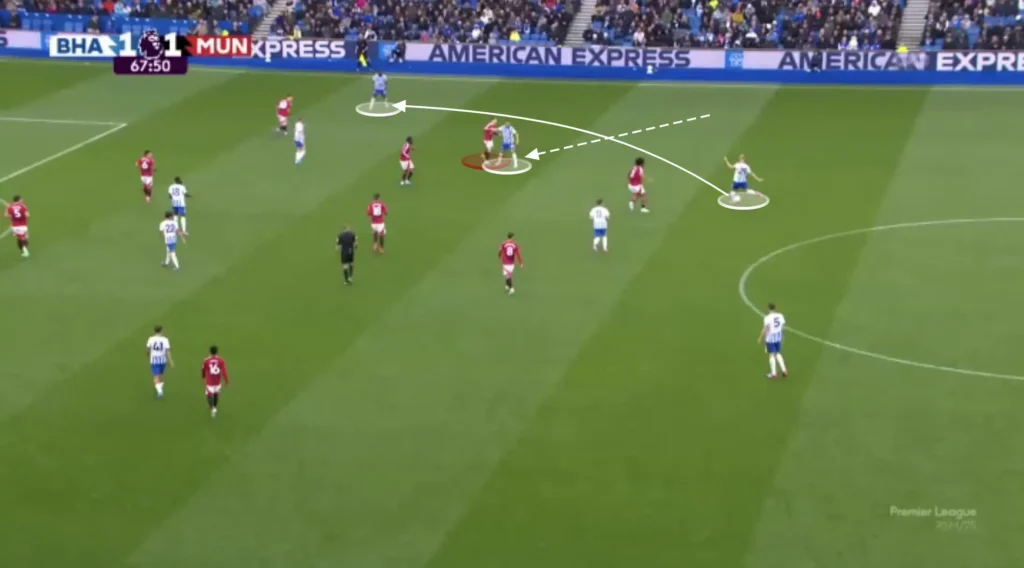
Numerical Advantage in the midfield
Having only the two wingers out wide and the rest in the middle creates more options in the center and less space between the players. Hürzeler likes this because he prioritizes playing through the middle. He needs one player out wide to pull the opposition apart while the rest create numerical advantages in the midfield areas. When a team outnumbers the opposition in the midfield, it can more easily retain the ball, exploit spaces, and progress the ball through the center. This advantage forces the opposing team to chase the game, which can lead to defensive errors and create opportunities for breaking down their defense. At the same time, it builds good conditions in defensive transitions since it allows more players to counterpress when they lose the ball.
Another purpose for keeping many players in the middle is to shorten the distance between them. This shortens the length of the passes, which naturally shortens the time between passes. This means the opposition players will have less time to push up and press, giving the Brighton players more time and control.
High Backline (Off)
A massive aspect of Hürzeler’s high possession build-up is to have the defenders high up. This helps in the counterpress because they get closer to the center. Having more players close to the center who can win the ball back makes it difficult for the opposition to do anything when they win possession. Furthermore, the high backline shortens the distance between players, shortening the time and length of the passes and preventing the opposition from pushing up their defense.
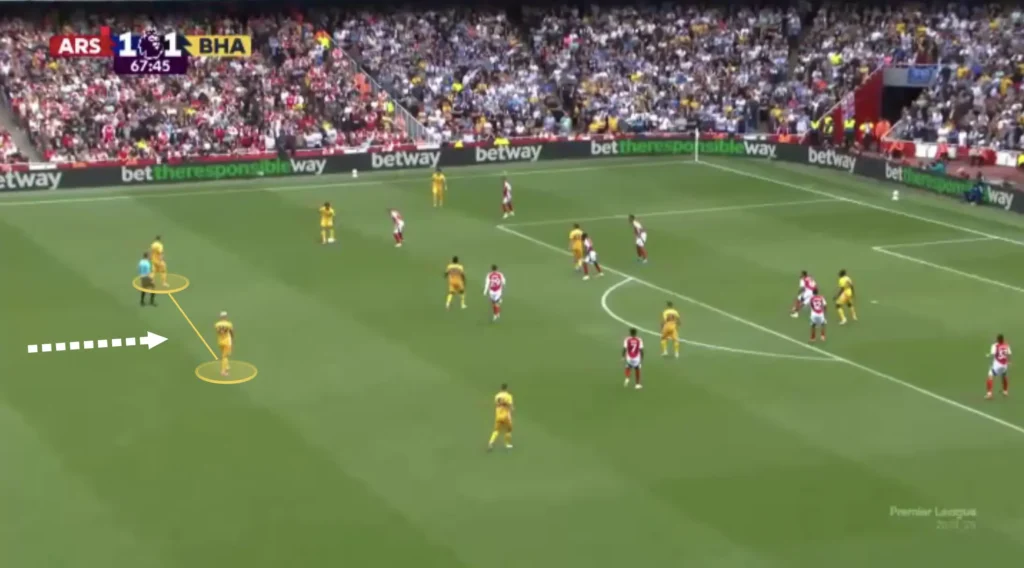
Fluidity
Brighton’s fluidity in the build-up under Fabian Hürzeler has been a key aspect of their tactical evolution. The team often adopts a dynamic approach, shifting between formations to create numerical advantages and exploit spaces. Hürzeler emphasizes versatility, with players interchanging positions seamlessly to maintain possession and disrupt the opposition’s defensive structure. Their most frequent rotation is when the attacking midfielder and inverted fullback switch places to pull their defenders away and create more space and confusion.
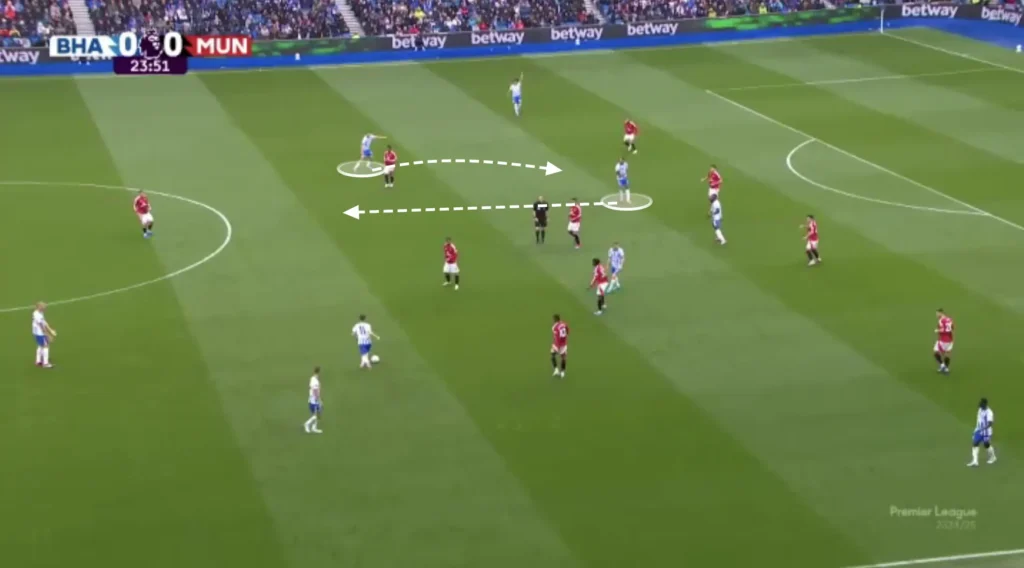
While it demands a lot of technical and tactical skills from the players, this fluidity has created new dynamics for Brighton’s attacking style, offering new solutions and ways of beating the opposition’s press. It enhances their ability to control the game while opening up opportunities for incisive passes and creative plays.
Linking with the Striker
Fabian Hürzeler likes to create central overloads when attacking the opposition. Therefore, the Brighton striker often drops during the build-up. When the striker drops, Brighton unlock more ways of beating the opponent’s defense. They can pass the ball to the striker, who can find an attacking midfielder in the pocket or play a one-touch pass out to the winger.
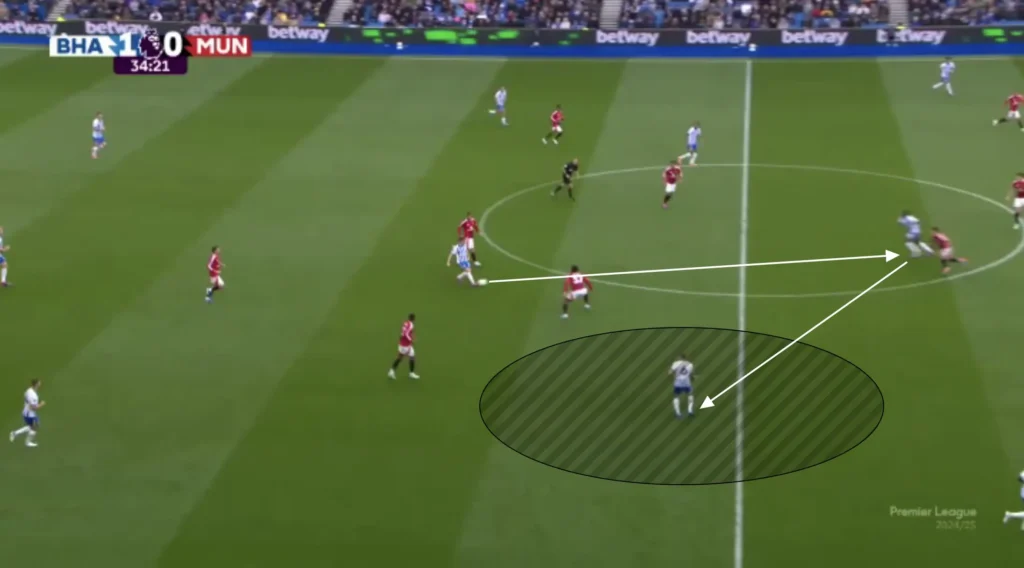
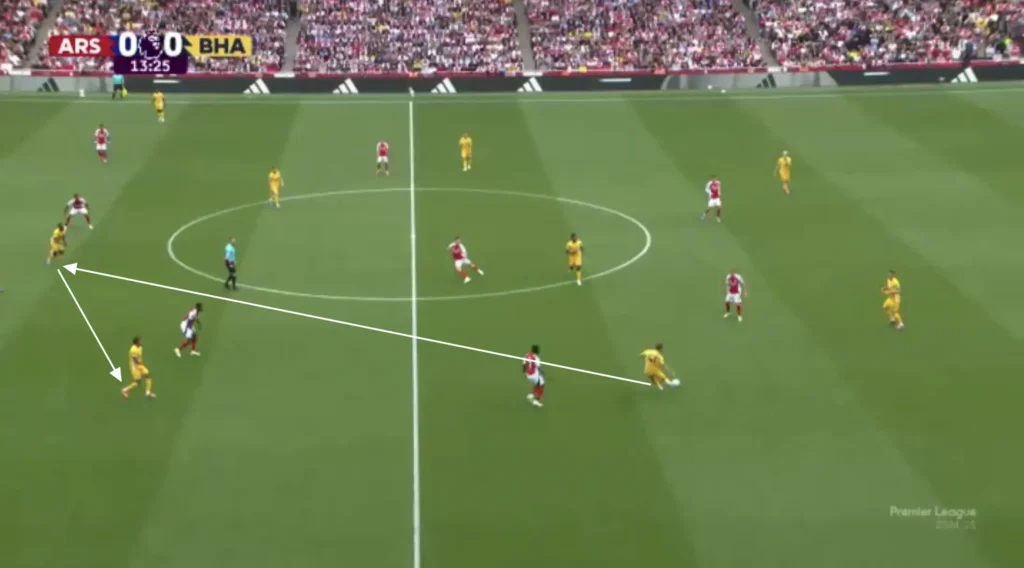
If the center-back pushes up on the striker, the space in behind opens up. When that happens, Brighton will exploit the space in behind with runs from the wingers or attacking midfielders.
Numerical Advantage Against the Opposition Backline
Another massive aspect of Brighton’s high build-up is their ability to create numerical advantages against the opposition’s defensive line. Playing with a front five means the forward line naturally becomes numerically superior against a back four, which they are great at taking advantage of.
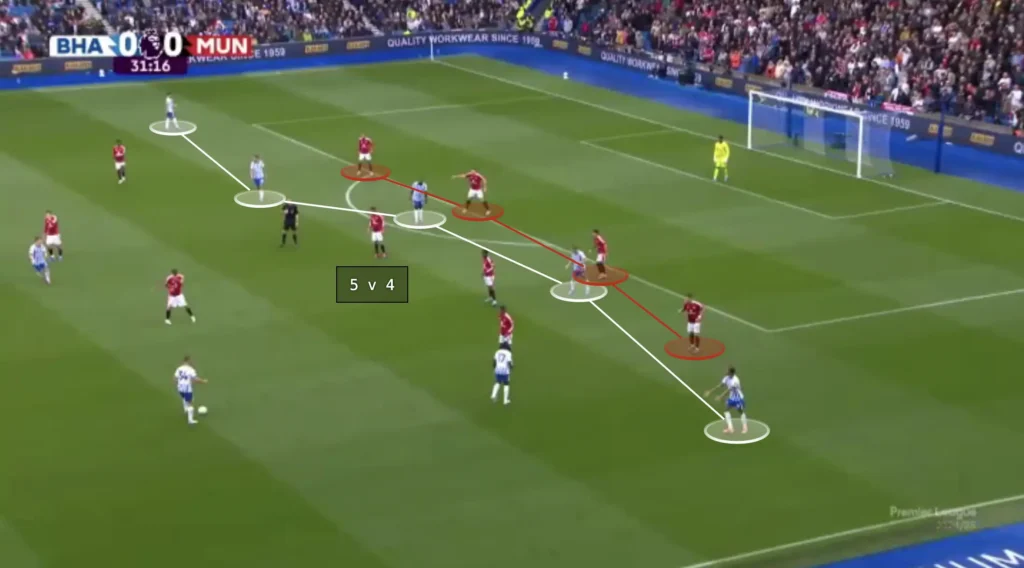
They mainly exploit this by creating 2v1 situations against the opposition fullback. When the defending team is positioned on one side, the weak-side fullback becomes vulnerable to the long switch of play due to the 1v2 against Brighton’s winger and attacking midfielder. The attacking midfielder will make a run in behind, the fullback will follow that run, and the space for the winger out wide will be opened. Hürzeler’s team often capitalizes on this by getting the ball to the winger and creating many opportunities from 2v1 situations on the wing and in the half-spaces.
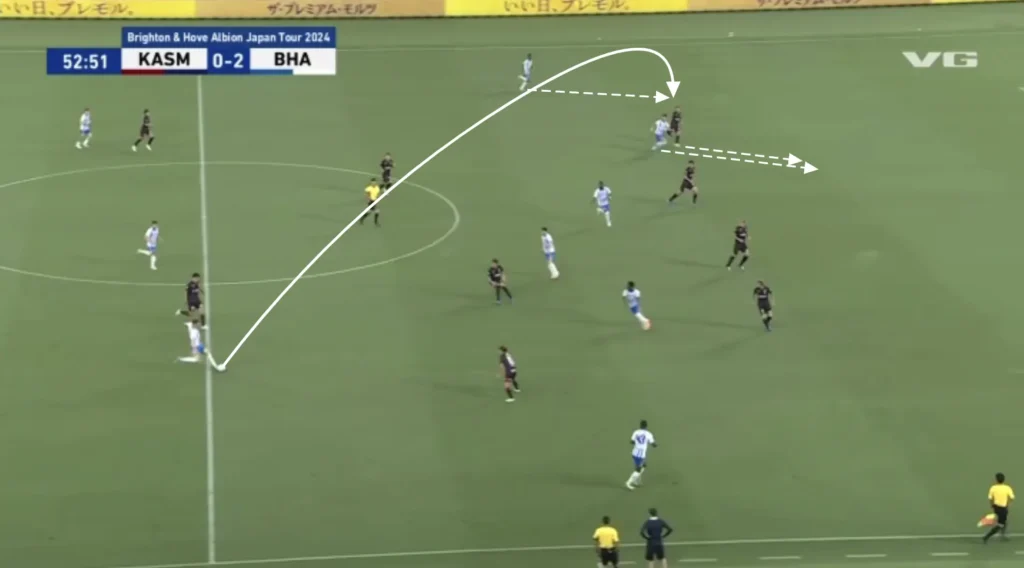
If the opposition fullback does not follow the attacking midfielder’s run, a through-ball could be played straight to the attacking midfielder, who could take the ball forward and create a 1v1 against the goalkeeper.
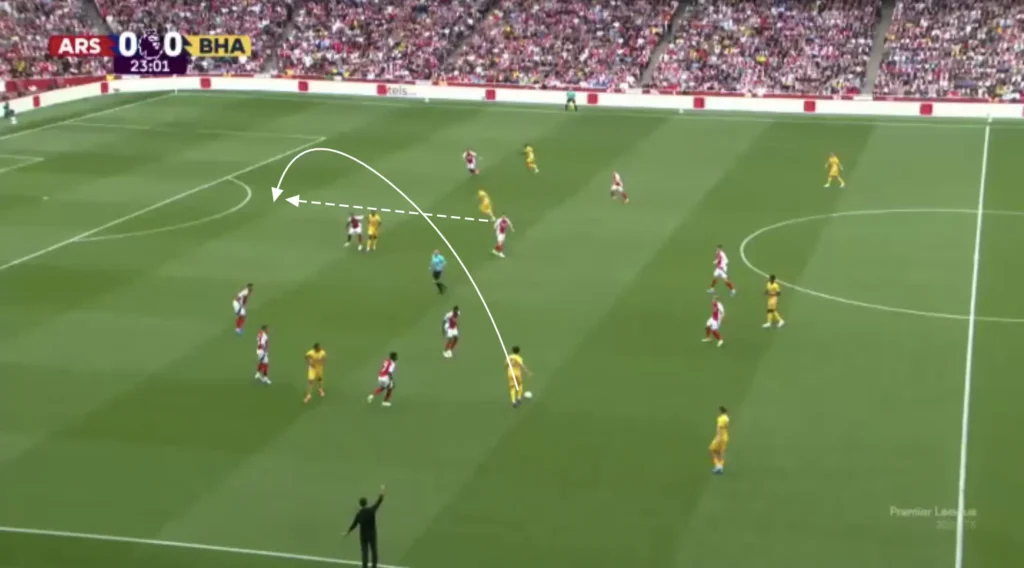
Final Third
Attacking the Half-Space
Hürzeler’s players usually look to create chances by attacking the space between the opposition center-back and fullback. They primarily do this from the wide areas with underlaps from the attacking midfielders. When the winger receives the ball out wide he will attract the opposition fullback. This opens the space between the fullback and the center-back, which allows Brighton’s attacking midfielder to make the underlapping run into this space. The ball can be played to the underlapping player, who can cross the ball into the box or attack his defender in a 1v1 situation.
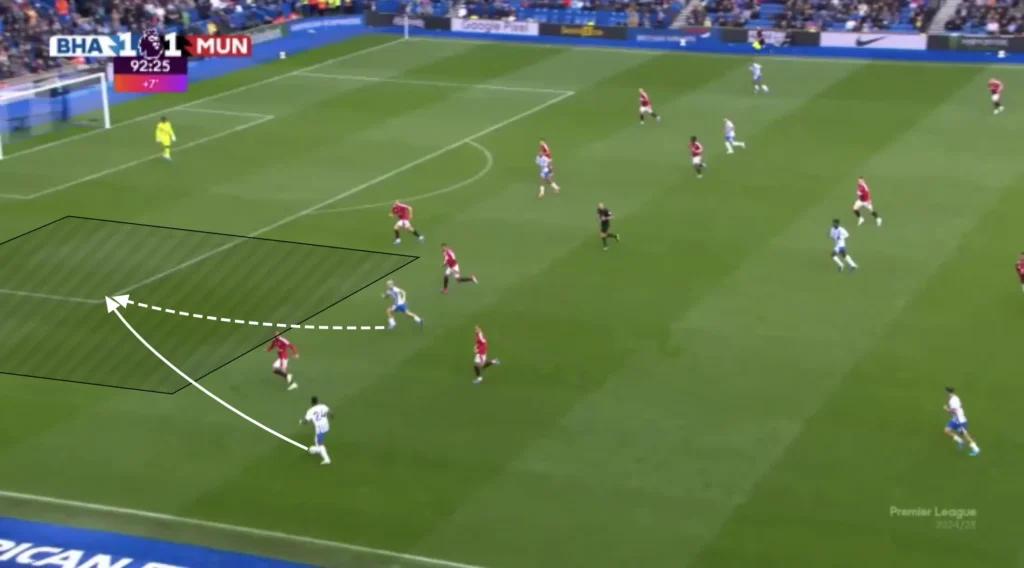
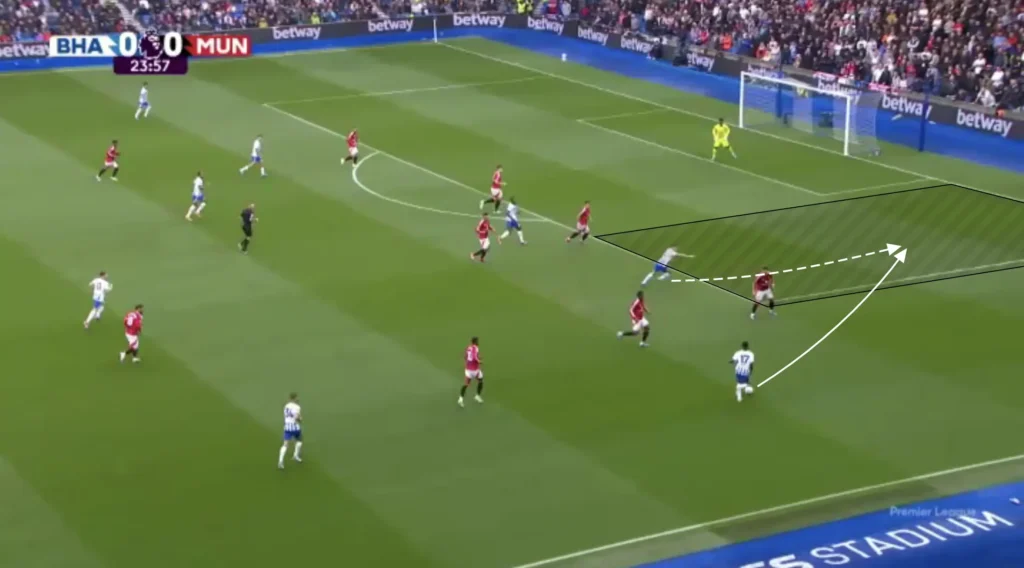
The winger does not have to play the ball to the underlapping player. The run from the attacking midfielder will often drag away an opposition defensive midfielder, which opens the space inside. The winger can take the ball inside and shoot or find a pass to a free player in front of the backline.
Overlaps
Brighton will also use overlaps to produce opportunities in the final third. When the winger gets the ball and the inverted fullback is nearby, the fullback can make the overlapping run, creating a 2v1 against the opposition fullback.
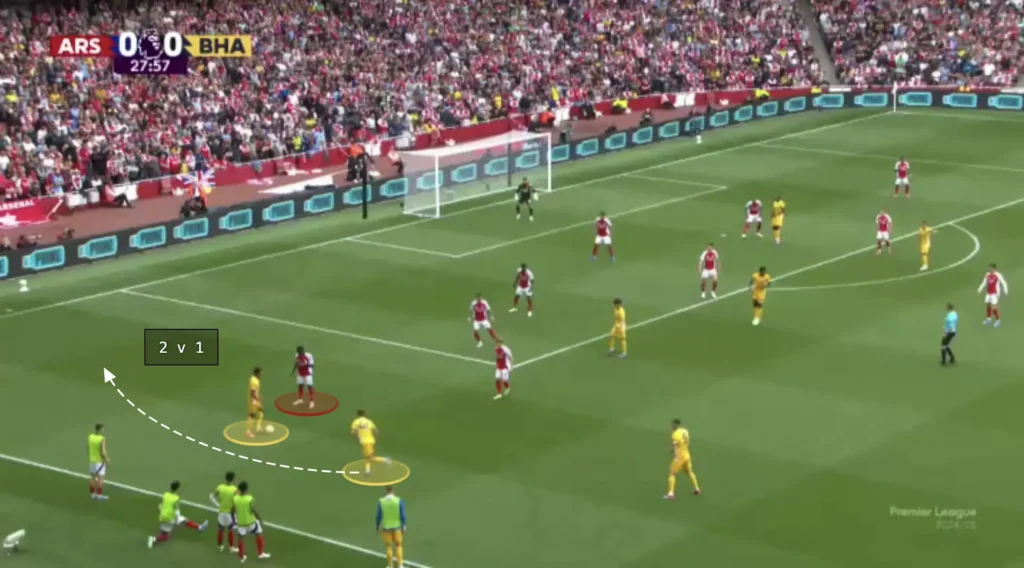
If the opposition fullback drops to cover the overlapping run, the winger could cut inside, taking a shot or combining with a midfielder. If the fullback covers the center, the ball can easily be played to the overlapping player, creating a crossing opportunity.
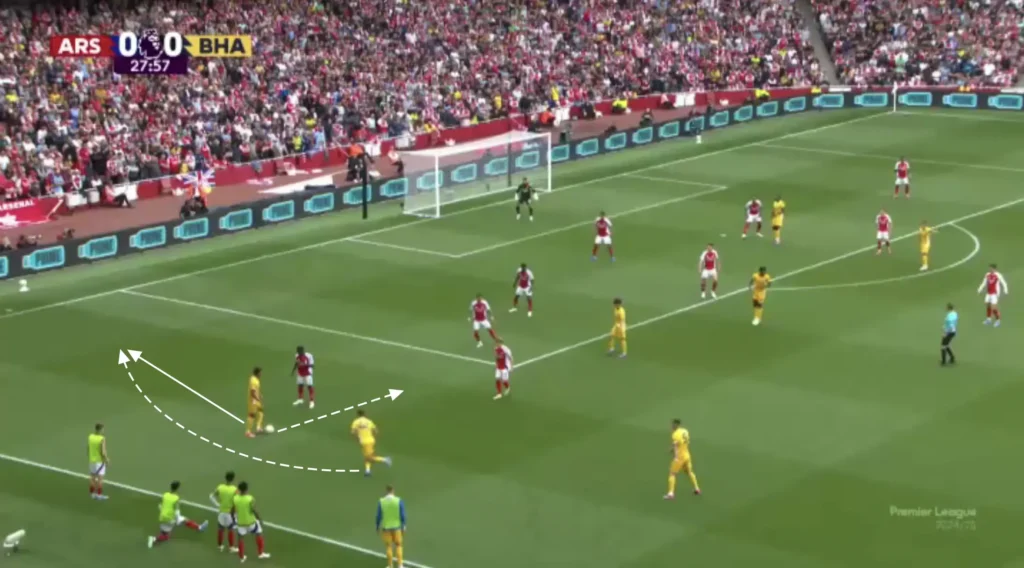
Many Players in the Box
The attacking midfielders and wingers look to make runs into the box when the ball is in the final third, often getting four or five players into these areas to create overloads. The numerical advantages in the box increase the chances of connecting with the cross, as more players present multiple targets for the crosser, making it harder for defenders to mark everyone effectively. Additionally, having multiple players in the box provides options for different types of finishes, whether it’s a header, volley, or a quick tap-in. It also allows for better positioning to react to second balls or rebounds, increasing the likelihood of capitalizing on any defensive errors.
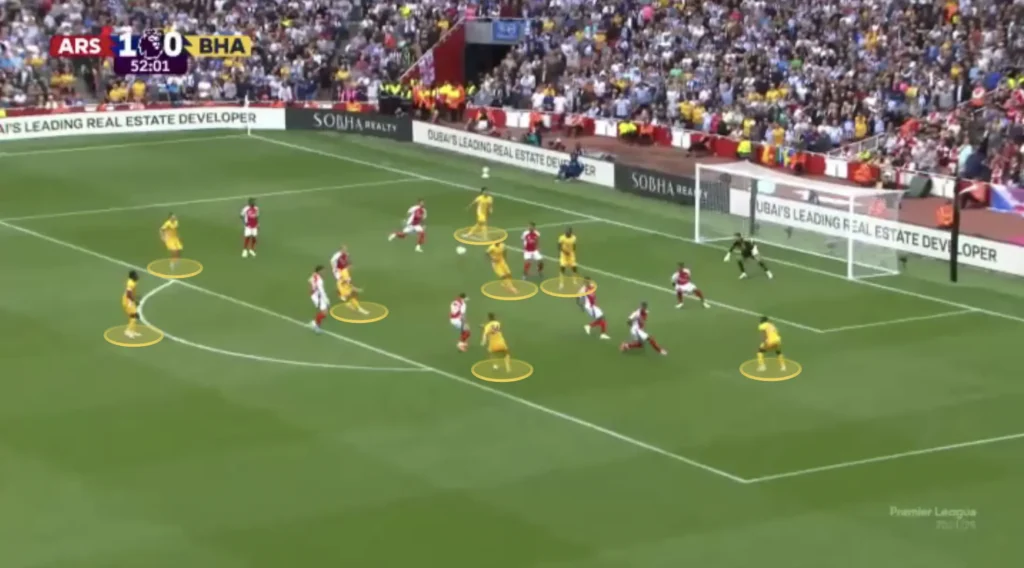
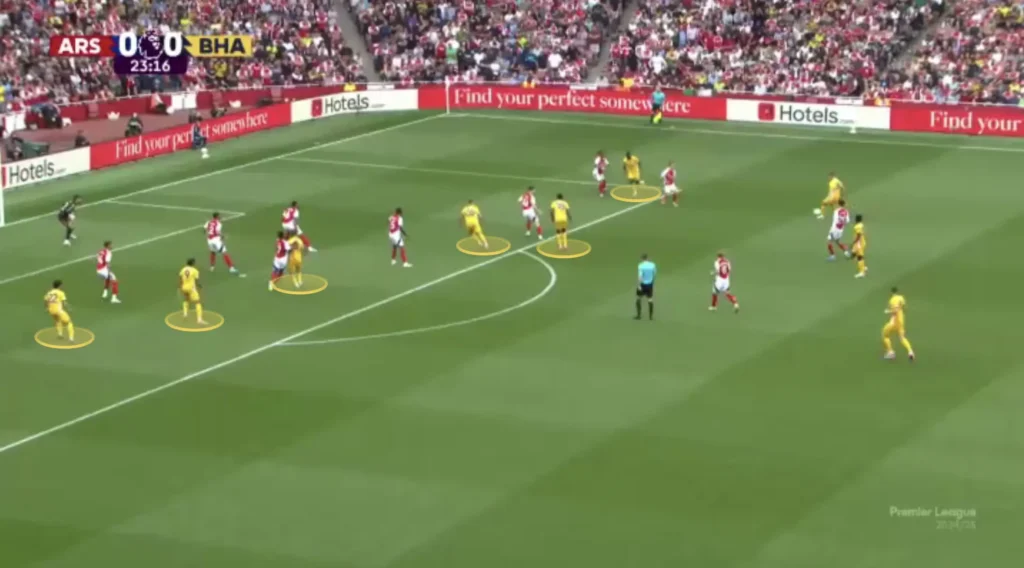
Hürzeler also positions many players outside the box, ready for the second balls and cut-backs. Brighton will often create crossing opportunities, which pushes down the opposition’s defense and opens the space in front of the opposition’s backline. The holding midfielders can collect any loose balls or be found directly in these spaces with cut-backs, and from there, they can shoot or combine with an attacker to create goalscoring opportunities.
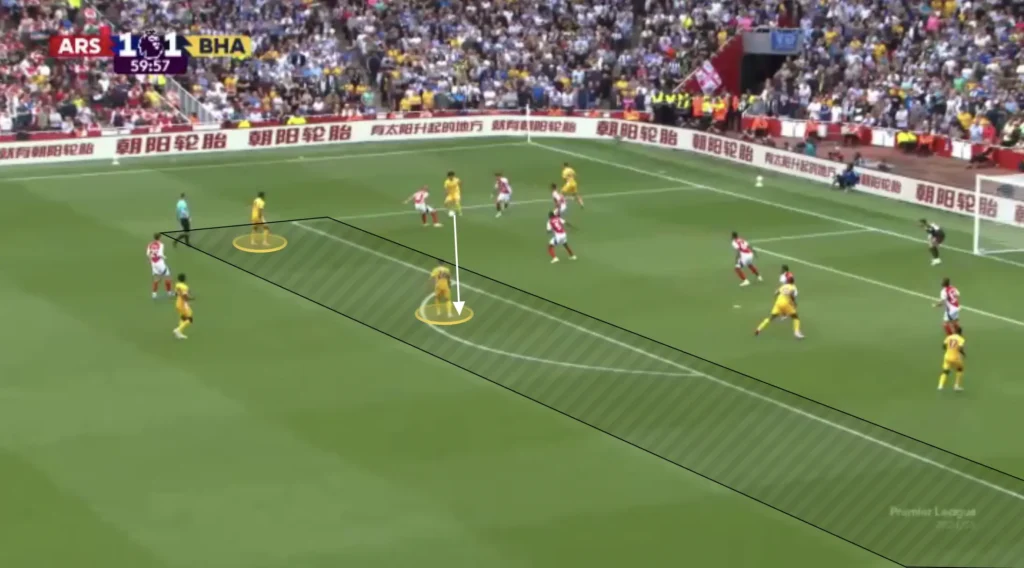
Defending
High Press
Hürzeler places much value on being aggressive without the ball. This shows in Brighton’s high pressure. Hürzeler usually wants his team to go man-to-man and intensely press the opposition. Each player is assigned a direct opponent to mark tightly, ensuring no easy passing options are available. This intense pressure forces the opposing team into hurried decisions, often resulting in turnovers in dangerous areas. Brighton almost use their high press as an attacking threat, scoring many goals from winning the ball high up the pitch.
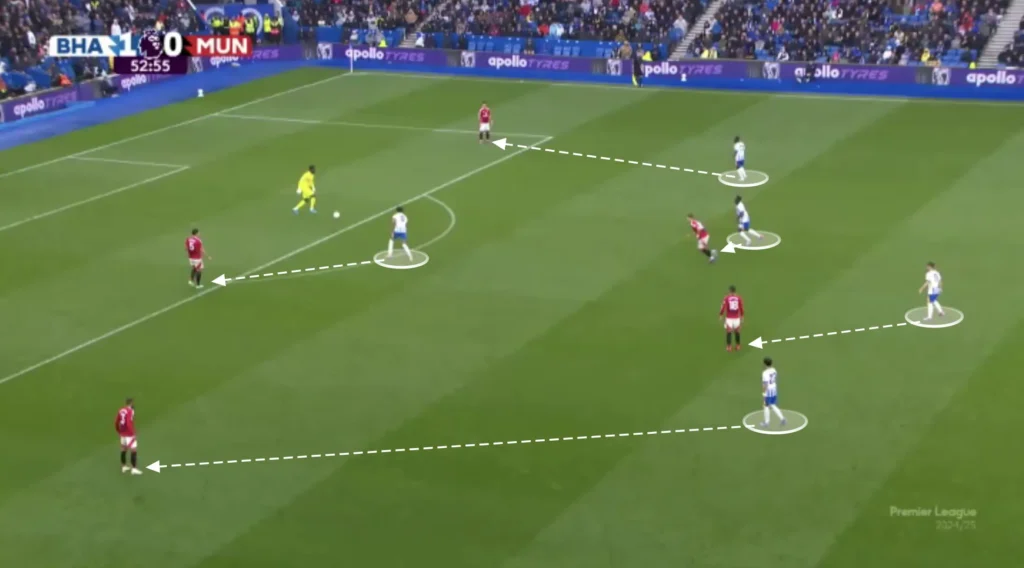
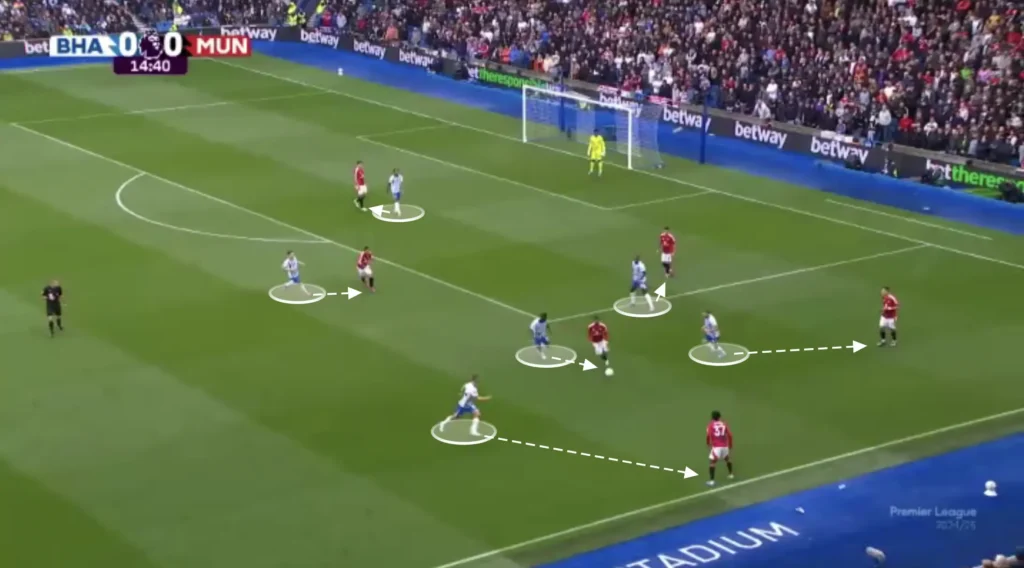
In a man-to-man system, it becomes crucial that the players know when to mark the opponent they are responsible for and when not to. If an opponent, for example, is very far from the ball, the Brighton player marking him does not need to be as close to him. He can instead come in and help create numerical superiorities in the center, decreasing the risk of dangerous 1v1 situations. Here, the ball is on the right side, allowing the Brighton players on the left side to stop marking their opponents as closely and come into the middle.
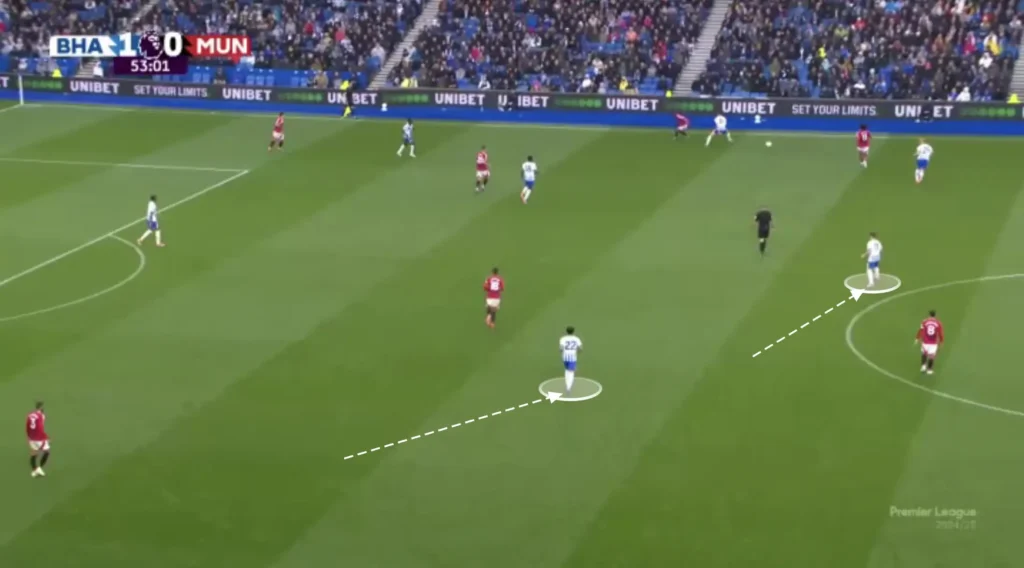
A rule of thumb for the players could be that the closer you are to the ball, the closer you need to be to your opponent. The further away you are from the ball, the further away you can be from your opponent.
Low Press
Brighton’s base formation when defending is the 1-4-4-2 formation. They look to set up in a mid-block, always trying to close the center and force the opposition out wide. Defending in the 1-4-4-2 formation is all about balance, compactness, and discipline. The team defends in two compact lines of four, with the forwards positioned ahead of the midfield. The two forwards play a crucial role, not only as the first line of defense but also in initiating the team’s pressing strategy. Hürzeler wants his team to stay compact without dropping too low, preferably closing the space between the midfield and backline.
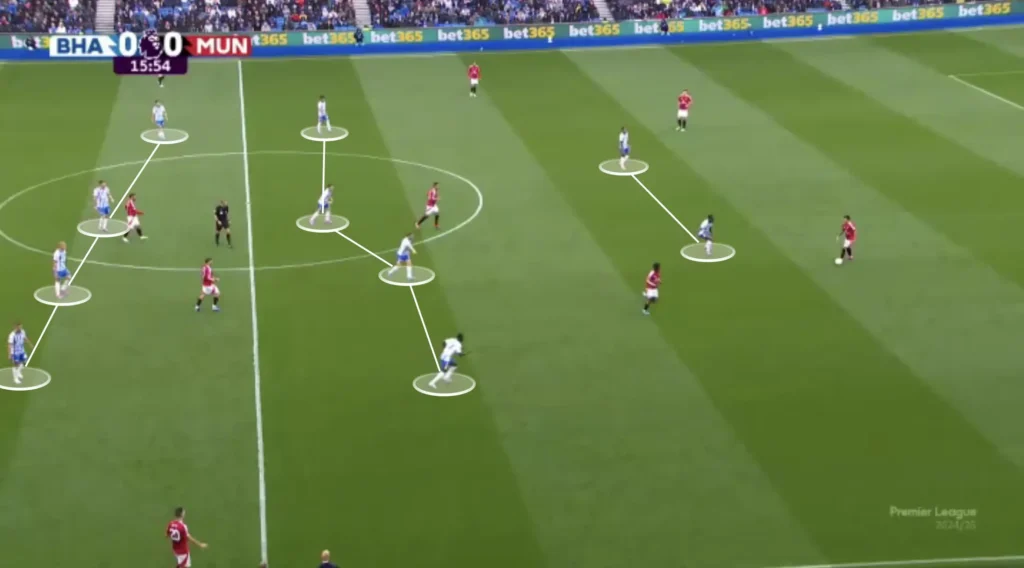
When Brighton get pushed down deep into their own half, one or both wingers sometimes drop down into the backline, creating a back five or even back six. This rotation mainly occurs when the opposition plays with a front five. The Brighton wingers coming down means they will be in a 6v5 numerical advantage at the back instead of a 4v5 numerical disadvantage.

Higher up the pitch, Brighton will sometimes set up in a 1-4-2-4 formation, with the wingers pushing up next to the strikers.
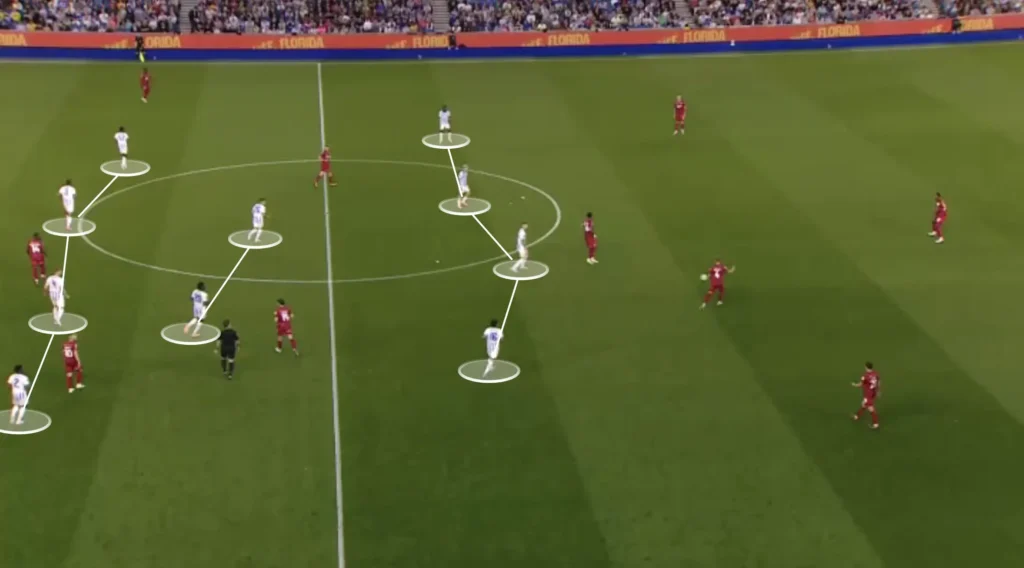
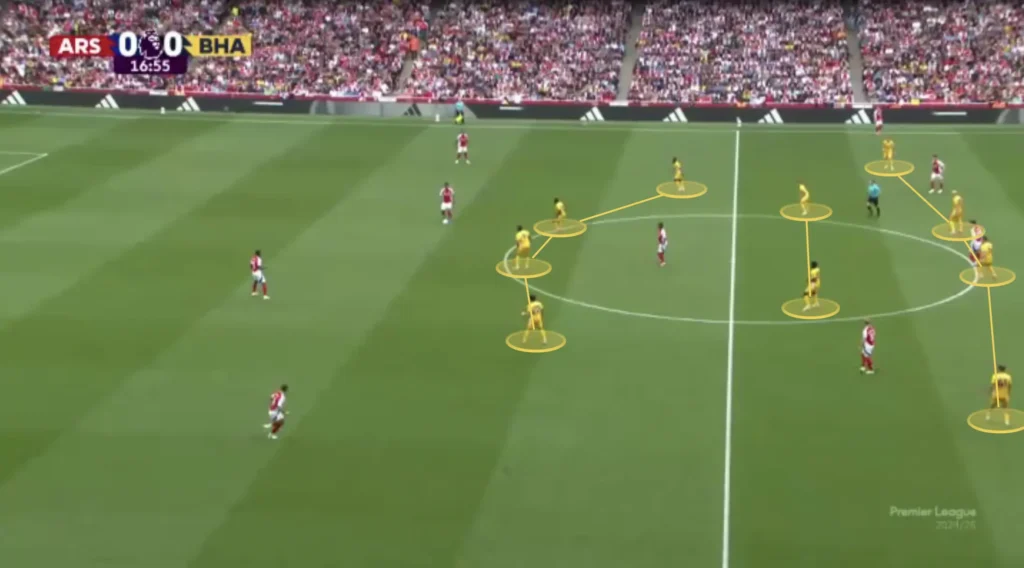
In Brighton’s 1-4-2-4 formation, the wingers will press the opposition center-backs while the two strikers cover the opposition’s holding midfielders.
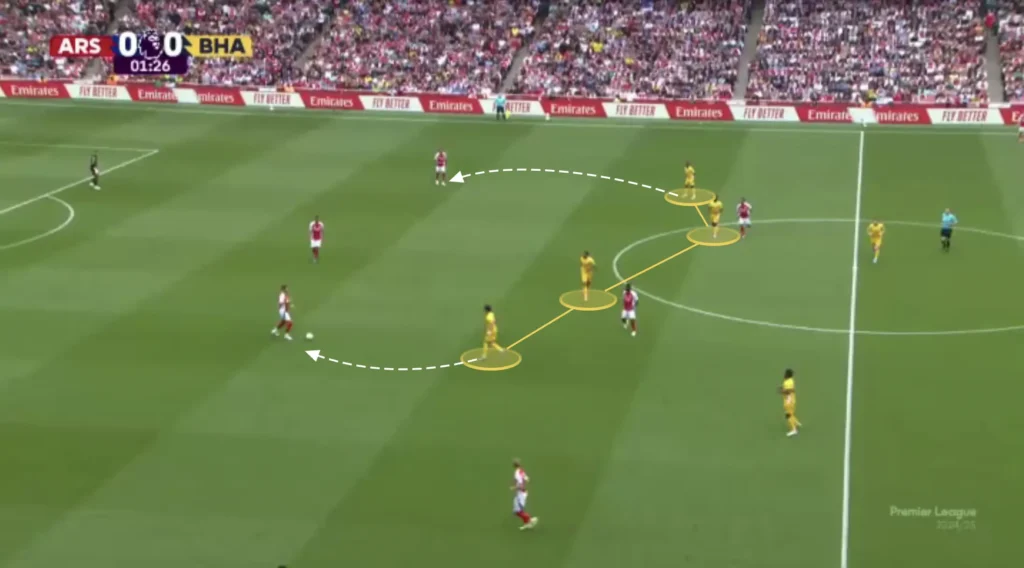
When the wingers press the center-backs, they close the passing lanes to the opposition fullbacks/wingbacks. This forces the opposition center-backs into the middle, where Hürzeler wants to win the ball with the strikers, who block off all passes to the opposition midfielders.
High Backline (Def)
One tool that helps to be compact is to play with a high backline, making the space to the midfield line as small as possible. Hürzeler’s players do this and usually try to keep the highest line they can without leaving the space behind them too open. Defending with a high backline involves positioning the defensive line closer to the midfield, rather than near the goalkeeper. This tactic compresses the space available for the opposing team to operate, disrupting their build-up play and increasing the chances of winning the ball back quickly.
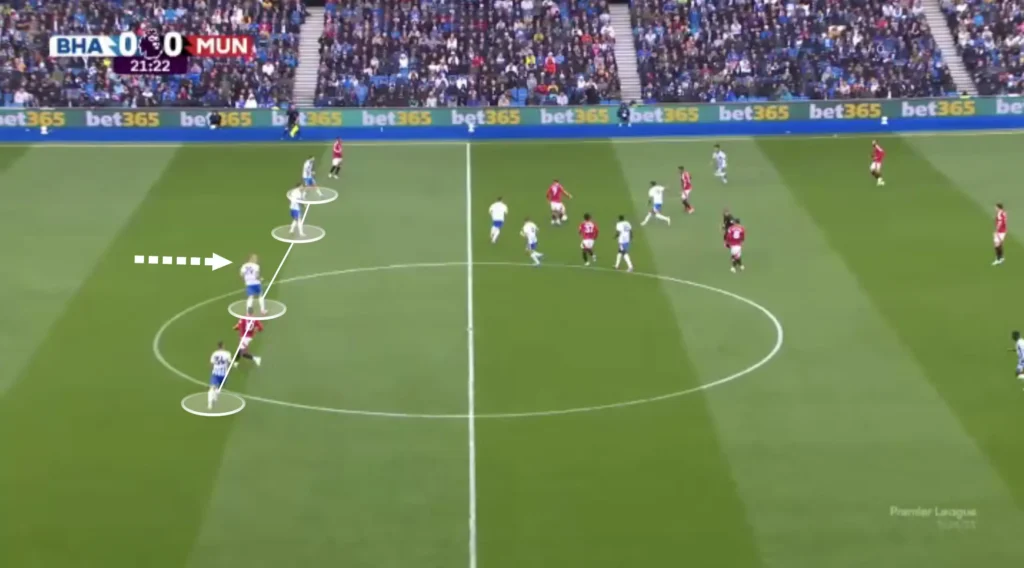
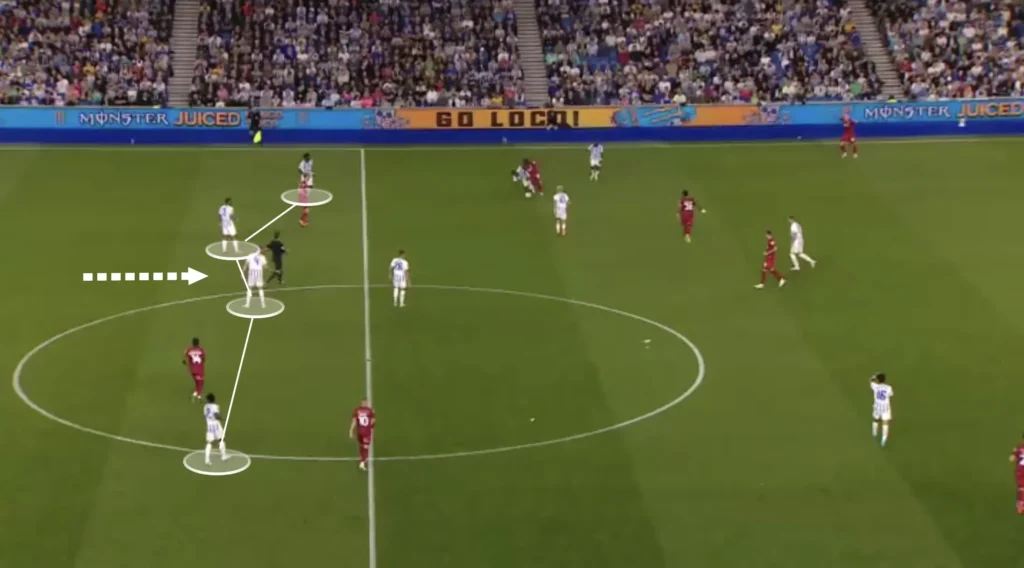
A high backline also allows defenders to support the midfield more effectively, creating numerical superiority in central areas and facilitating quicker transitions from defense to attack. However, it requires defenders with good pace and positional awareness to deal with long balls and prevent opposing attackers from exploiting the space behind. This approach demands constant communication and coordination among the backline to maintain a cohesive and effective defensive structure.
Everyone must be in the same line when defending with a high backline to maintain an effective offside trap, ensure cohesive coverage, and reduce gaps that attackers can exploit. A well-aligned defensive line makes it easier to catch opposing forwards offside, preventing them from receiving the ball in dangerous positions. Additionally, this alignment helps defenders support each other, allowing for quick transitions and coordinated movements to tackle, intercept, and clear the ball.
Squeezing the Pitch
Fabian Hürzeler always wants his team to squeeze the pitch when defending. This means constantly pushing the team up as much as possible. Every time the opponent plays a slow, sideways pass or a back pass, Brighton’s first line of pressure pushes up, with the rest of the team following to stay compact. When the next pass comes, they push up even more, forcing the opponent back even more. They do this because it pushes the opponent further away from Brighton’s goal, making it harder to create chances.
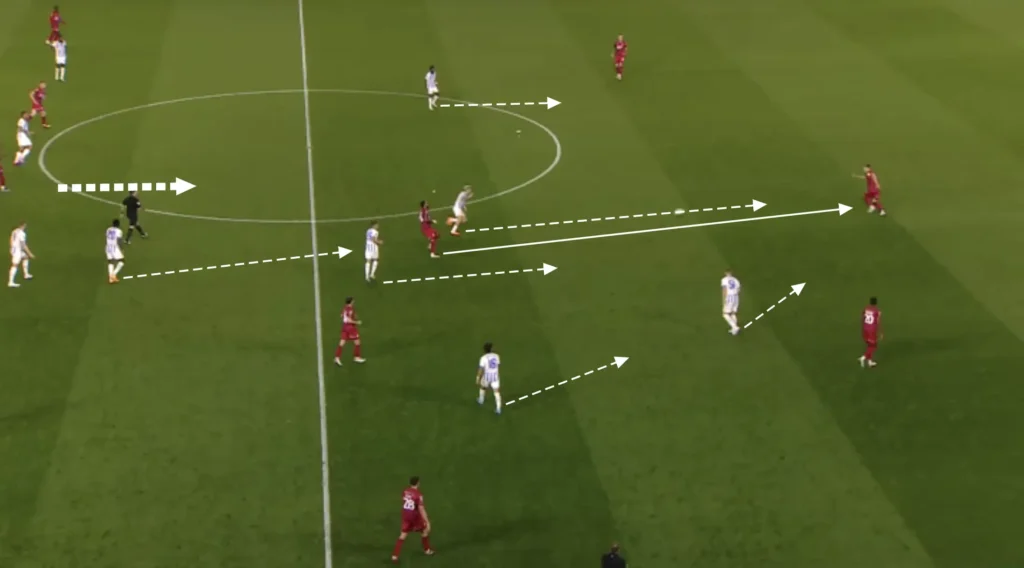
Transitions
Defensive Transitions
Positioning many players centrally, creating a numerical advantage in the midfield, creates good conditions in defensive transitions. Many players close to the ball after losing possession means that many players can work towards regaining possession. Hürzeler’s players are also very aggressive in the first seconds after losing the ball. The four or five players closest will immediately jump on the opposition player with the ball and close the distance to cut off any passing lanes. This approach disrupts the opponent’s transition from defense to attack, forcing errors and creating opportunities to regain control in dangerous areas.
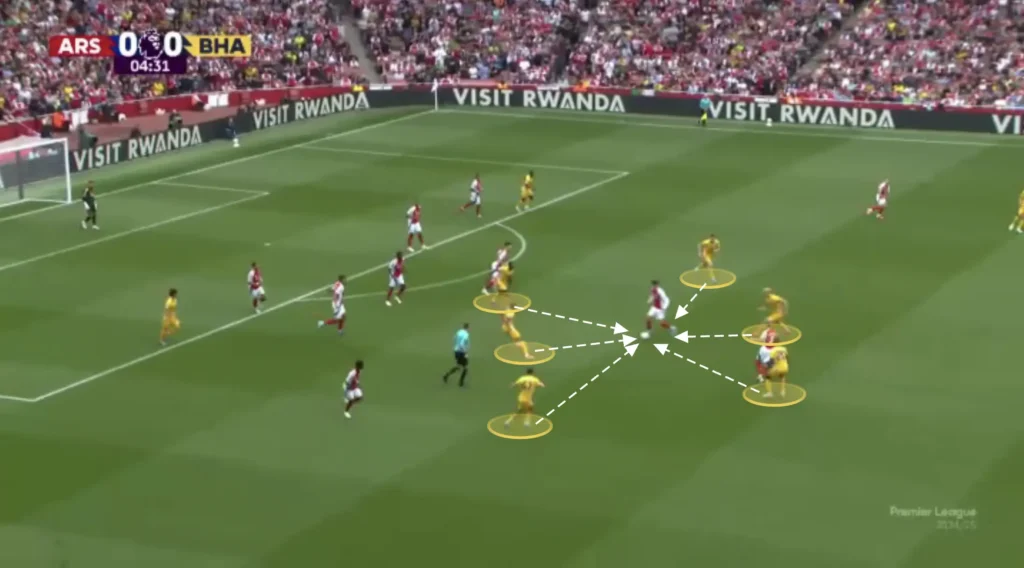
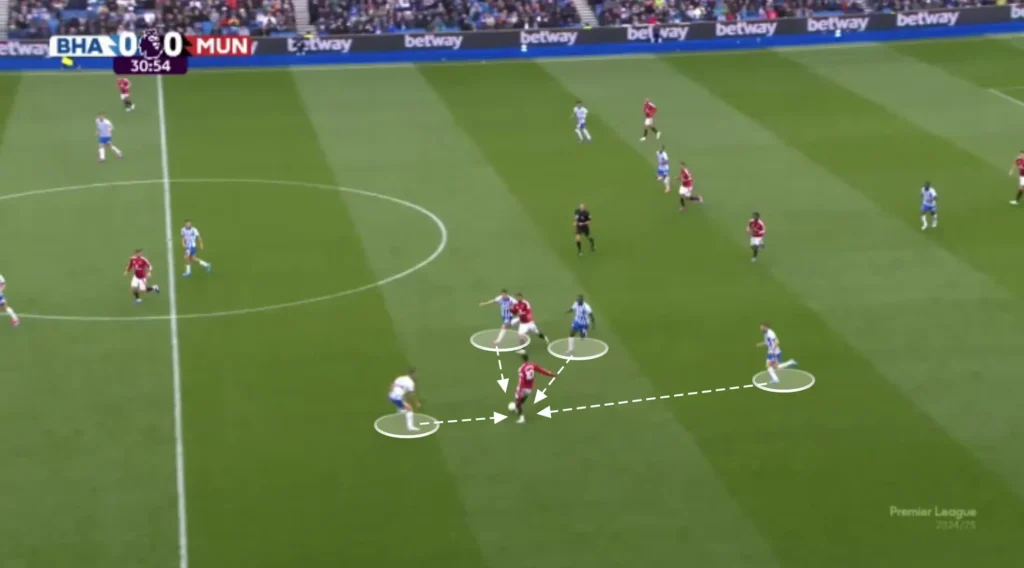
Counterpressing like this keeps Brighton on the front foot, allowing them to dominate possession and create more scoring opportunities. However, it requires exceptional fitness, tactical discipline, and teamwork.
Offensive Transitions
Fabian Hürzeler also wants his team to counterattack in their offensive transitions. When winning the ball back, the team transitions quickly from defense to attack, utilizing the speed and movement of their forward players. Hürzeler emphasizes vertical passes to exploit spaces left by the opposition, often targeting wide areas or gaps between defenders. Brighton’s counterattacks are well-organized, with players making intelligent off-the-ball runs to create overloads and support the ball carrier. This quick, direct style catches opponents off guard, making Brighton a dangerous team on the break. Additionally, Brighton’s aggressiveness means they have many players high up when defending, which enables them to incorporate more players into the counterattacks.
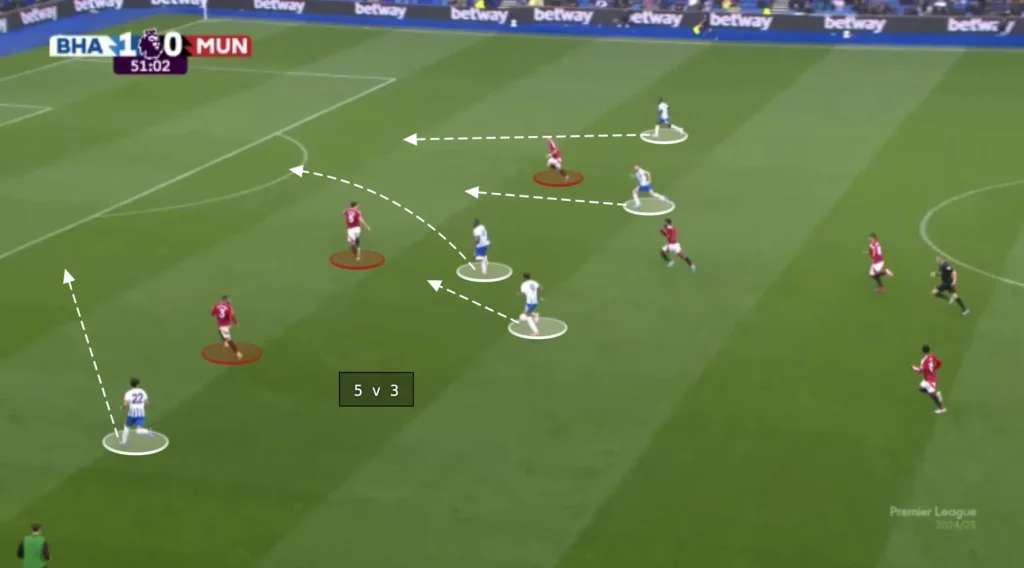
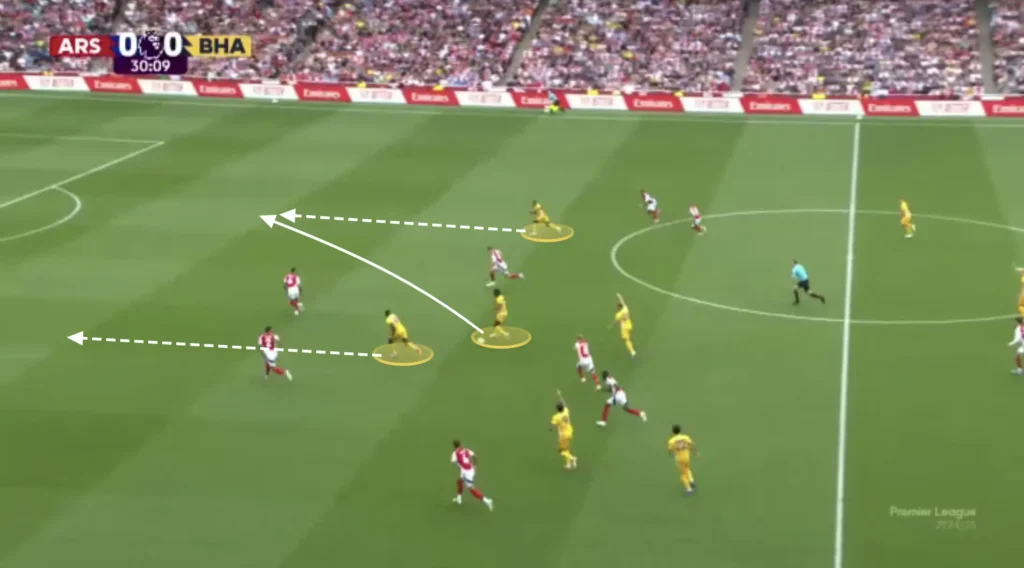
Final Thoughts
In conclusion, Fabian Hürzeler’s tactical approach at Brighton showcases a blend of modern football strategies with a strong emphasis on flexibility and structure. His ability to adapt formations, press intelligently, and exploit space highlights his tactical awareness and understanding of the game. Brighton’s balance between solid defensive organization and fluid attacking play is a testament to Hürzeler’s coaching style, which seeks to maximize the potential of his players.
As Brighton continues to develop under Hürzeler’s guidance, his tactical innovations and approach will likely shape the team’s success moving forward. This analysis underscores his commitment to progressive football and his ability to adapt to the ever-evolving demands of the modern game.
